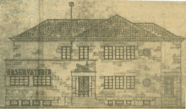U.Porto Memory
U.Porto - Buildings with history
Astronomy Observatory of Professor Manuel de Barros
 The Astronomy Observatory of Professor Manuel de Barros, dependent on the Faculty of Sciences of the U.Porto, was established in 1948 to meet the needs of Mathematics and Geographic Engineering students in Astronomy classes. Over time, teaching and research activities have taken place there in the areas of Earth, Space and Geographic Engineering Sciences.
The Astronomy Observatory of Professor Manuel de Barros, dependent on the Faculty of Sciences of the U.Porto, was established in 1948 to meet the needs of Mathematics and Geographic Engineering students in Astronomy classes. Over time, teaching and research activities have taken place there in the areas of Earth, Space and Geographic Engineering Sciences.
The name of the Observatory is due to Manuel Gonçalves Pereira de Barros, a teacher of the Faculty of Sciences committed to setting up an Observatory at the University of Porto where students could study Astronomy, which he directed until 1968. As the Director of the Astronomy Office, Professor Ruy Luís Gomes was responsible for choosing the location of the observatory - the Monte da Virgem Promenade, in Vila Nova de Gaia.
The project of the building was prepared by the Directorate of National Buildings and Monuments, north delegation of the Ministry of Public Works, and the building was completed in 1957, as well as the equipment necessary for the Observatory.
On 19 April 1968, the Delivery and immediate transfer of the buildings for the Meridian Circle and East Telescope of the Astronomy Observatory of the Faculty of Sciences of the University of Porto – Monte da Virgem – Vila Nova de Gaia was signed by the Directorate of Buildings and National Monuments of the North and the University of Porto, represented by its Rector, Professor Manuel Correia de Barros Júnior.
In the book "The Buildings of the University of Porto: Projects", edited by the University of Porto in 1987, we are told that the Observatory had classrooms, a library and workshops, and it was "organized into basement and two floors, the architecture [was] unpretentious – one of the volumes brings out the light onto one of the entrances and values another, the main entrance, sheltered under a veranda of the upper floor." [pp. 42-43].
Over the years, the Observatory was used by students of all levels of education. In addition to study visits, is was open to the public on special occasion, for example, the passage of the Comet Hale-Bopp in 1997, and the solar eclipse in August 1999.
Last updated: 2012-05-18 Webpage created on: 2024-05-10 08:32:04 Complaint Portal